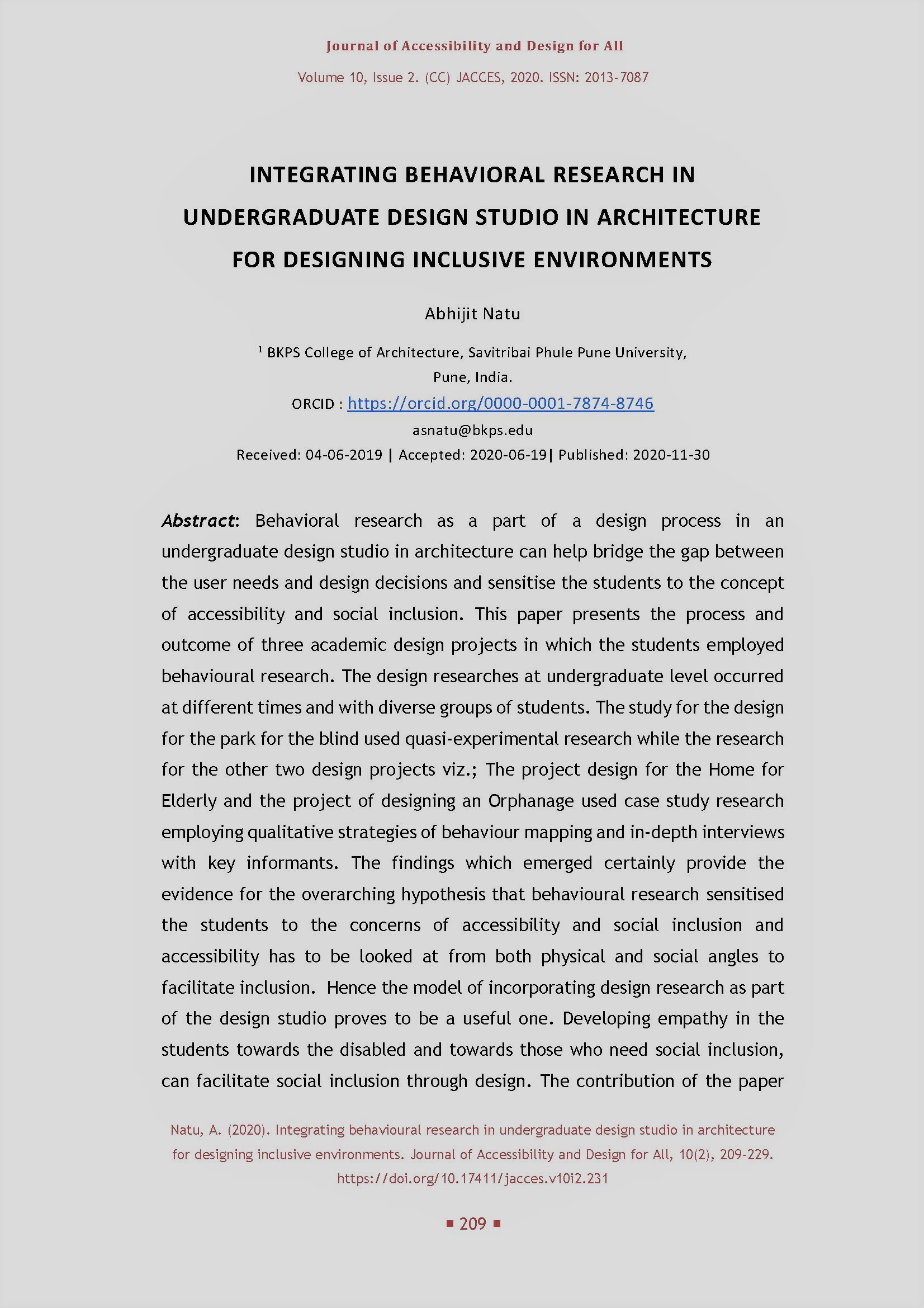Integrating behavioral research in undergraduate design studio in architecture for designing inclusive environments
DOI:
https://doi.org/10.17411/jacces.v10i2.231Abstract
Behavioral research as a part of design process in undergraduate design studio in architecture can help bridge the gap between the user needs and design decisions and sensitize the students to the concept of accessibility and social inclusion. This paper presents the process and outcome of three academic design projects in which the students employed behavioral research. The design researches at undergraduate level occurred at different times and with different groups of students. The research for the design for the park for the blind used quasi experimental research while the research for the other two design projects viz.; Home for Elderly and Orphanage used case study research employing qualitative strategies of behaviour mapping and in depth interviews with key informants.The findings which emerged certainly provide the evidence for the overarching hypothesis that behavioural research sensitized the students to the concerns of accessibility and social inclusion and accessibility has to be looked from the point of view of both physical as well as social angles to facilitate inclusion. Hence the model of incorporating design research as part of the design studio proves to be a useful one. Developing empathy in the students towards the disabled and towards those who need social inclusion, can facilitate social inclusion through design. The contribution of the paper lies in development of a framework for design research for undergraduate students of architecture for inclusive design.
References
Bashier, F. (2014). Reflections on architectural design education: The return of the rationalism in the studio. Frontiers of Architectural Research, 3, 424-430. https://doi.org/10.1016/j.foar.2014.08.004
Berleant, A. (1988). Aesthetic Perception in Environmental Design. In J. L. Nasar, Envrionmental Aesthetics : Theory, Research and Applications (pp. 84-97). Cambridge: Cambridge University Press. https://doi.org/10.1017/CBO9780511571213.010
Boyer, E. L., & Mitgang, L. D. (1996). Building Community: A new future for architecture education and practice. New Jersey: The Carnegie Foundation.
Chakravarti, P. (1993). Learning from Ordinary Places. Ekistics, 60 (1), 305-308.
Francis, M. (2001). A Case Study Method for Landscape Architecture. Landscape Journal, 20 (1), 15-29. https://doi.org/10.3368/lj.20.1.15
Groat, L., & Wang, D. (2002). Architectural Research Methods. NY: John Wiley and Sons Inc.
Hitch, D., Dell, K & Larkin, H. (2016). Does Universal Design Educaiton Impact on the Attitudes of the Architecture Students towards People with Disability. Journal of Accessibility and Design for All, 6(1), 26-48. DOI: 10.17411/jacces.v6i1.103
Heylighen, A., Doren, C. V., & Vermeersch, P. W. (2013). Enriching our Understanding of Architecture through Disability Experience. Open House , 38 (1), 7-19.
Kroemner, K. (2006). Extra Ordinary Ergonomics - How to accomodate small and big persons, the disabled and elderly, expectant mothers and children. Boca Raton: Taylor and Francis.
Laurie, M. (1975). An Introduction to Landscape Architecture. New York: American Elsivier Pub. Co. In.
Lindel, M. (1991). The Living Environment. In M. Shaw, The Challenge of Aging [2nd Ed.]. London: Churchill Livingstone.
Morrow, R. (2002). Building and Sustaining a Learning Environment for Inclusive Design: A Framework for teaching inclusive design within built environment courses in the UK. Online: Centre for Education in the Built Environment. Retrieved from Queens University Belfast Research Portal: https://pure.qub.ac.uk/ws/files/13453576/CEBE_Building_and_Sustaining_a_Learning_environment_for_inclusive_design_full_report.pdf
Mostafa, M. (2013). Expanding Normal: Towards a More Inclusive Approach to Designing the Built Environment. Open House, 38 (1), 4-6.
Nicolle, C., & Maguire, M. (2003). Empathic Modelling in Teaching Design for All. Retrieved October 18, 2018, from https://dspace.lboro.ac.uk: https://dspace.lboro.ac.uk/dspace-jspui/bitstream/2134/722/1/PUB184%20Empathic%20Modelling.pdf
Pallasmaa, J. (2009). The Thinking Hand: Existential and Embodied Wisdom in Architecture. London: John Wiley and Sons Ltd.
Roberts, A. (2007). The Link between Research and Teaching in Architecture. Journal of Education in the Built Environment, 2 (2), 3-20. https://doi.org/10.11120/jebe.2007.02020003
Rutledge, A. J. (1985). A Visual Approach to Park Design. NY: John Wiley and Sons.
Savitribai Phule Pune University. (2015, 12 1). 3-4-5 Detailed Syllabus [Annexure A]. Retrieved from www.unipune.ac.in: http://collegecirculars.unipune.ac.in/sites/documents/Syllabus%202017/3-4-5%20Detailed%20Syllabus%20[Annexure%20A].pdf
Teklenburg, J., Zacharias, J., John, H., & Teresa, V. (1996, August 3). Spatial Analysis in Environment Behavior Studies : Topics and Trends. Retrieved March 12, 2001, from IAPS 14 Conference - Evolving Envrionmental Ideals, Chaning Ways of life, values and Design Practices: www.bwk.tue.nl/bwk/urb/p/Jan/Spatial.htm

Downloads
Published
Issue
Section
License
Copyright (c) 2020 ABHIJIT SADASHIV NATU

This work is licensed under a Creative Commons Attribution-NonCommercial 4.0 International License.
- Authors retain copyright and grant the journal right of first publication with the work simultaneously licensed under a Creative Commons Attribution License that allows others to share or adapt the work with an acknowledgment of the work's authorship and initial publication in this journal. Use of the work for commercial purposes are not allowed.
- Authors are able to publish the journal's published version of the work in other media (e.g., post it to an institutional repository or publish it in a book), as far as they inform the Journal of Accessibility and Design for All of that fact. When publishing their work in other sources, authors must mention the name of the Journal of Accessibility and Design for All, its ISSN, the number and issue in which the article was published and a link to the main page of the Journal of Accessibility and Design for All. Optionally, they can also include a link to the article published in the Journal of Accessibility and Design for All.
- Authors are permitted and encouraged to post their work online (e.g., in institutional repositories or on their website), as it can lead to productive exchanges, as well as earlier and greater citation of published work.

